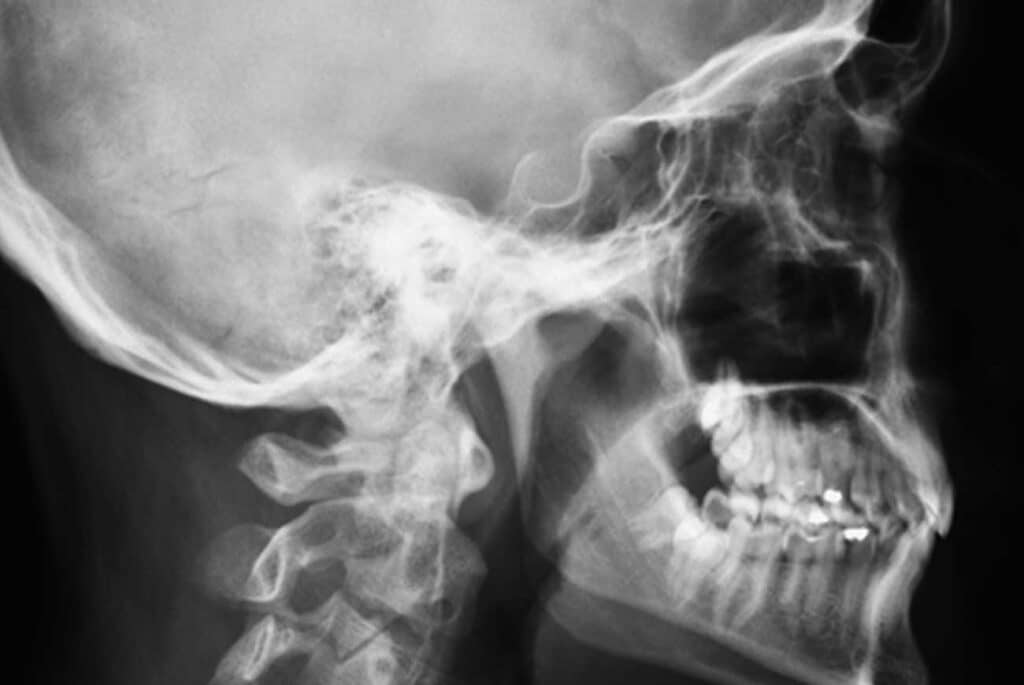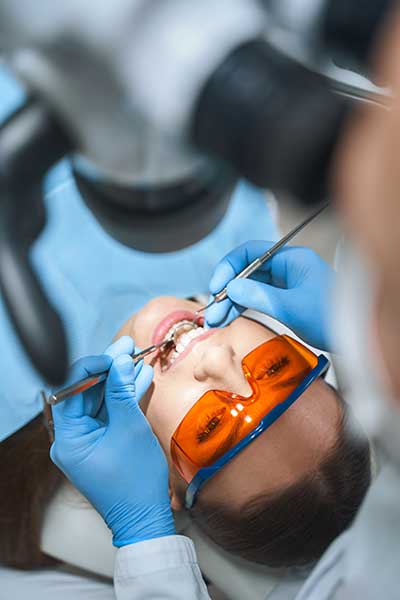Reconstructive Oral Surgery
Restore your natural-looking smile with reconstructive oral surgery.
Advanced dental reconstructive techniques for durable and effective results at our Jackson Square Mall dentist office.


Restore function.
Regain your smile.

What does reconstructive oral surgery mean?
Reconstructive oral surgery encompasses a wide range of procedures aimed at restoring the function, appearance, and health of your teeth and gums. This type of surgery is essential for individuals who have experienced significant dental issues such as trauma, severe decay, or congenital defects. By addressing these problems, reconstructive dental surgery can enhance your quality of life, boosting both your oral health and self-confidence.
Types of reconstructive oral surgery procedures
Reconstructive dental surgery has many use cases, and as such, there are a wide range of procedures that your dentist or oral surgeon may recommend to restore your smile to its best. The following are some of the most common reconstructive surgery procedures our office performs:
Dental implants
These are artificial tooth roots placed into the jawbone which fuse with your jawbone over time (osseointegration) creating a stable and secure base for attaching artificial teeth, such as crowns, bridges, or dentures. We use these when a patient’s natural teeth are missing or have deteriorated to such an extent as to not be functional and require removal.Bone grafts
Dental bone grafts are used to rebuild bone tissue in the jaw. This additional bone is often needed before dental implants can be placed. The grafted bone acts like a scaffold, encouraging your body to grow new bone tissue in the area. This creates a strong and secure foundation for dental implants, allowing them to integrate properly with your jawbone and function effectively.
Sinus lift
A sinus lift, also known as sinus augmentation, is a minor surgical procedure performed in the upper jaw. It’s done to create more bone in the area between the upper molars and premolars, where the maxillary sinuses are located. This is often necessary for those needing dental implants in the upper jaw.Ridge augmentation
Ridge augmentation, also known as alveolar ridge augmentation, is a dental procedure that rebuilds or strengthens the jawbone ridge where teeth are missing. This creates a stronger foundation for dental implants. Ridge augmentation can be performed during the same surgery as implant placement or as a separate procedure beforehand.Gum grafts
Gum grafting involves taking a small piece of healthy gum tissue from another area of your mouth and transplanting it to the area of recession to thicken and strengthen the gum tissue. This covers exposed tooth roots to protect from decay and sensitivity, prevent further recession and bone loss, restore a natural looking gumline, and improve overall gum health.
What are some common reasons for reconstructive dental surgery?
Trauma or injury: Reconstructive surgery can be required when trauma to the mouth has caused damage to the jawbone or soft tissues and needs to be repaired to restore function or prevent further complications.
Severe tooth decay: If tooth decay has reached the point of repair, an extraction and implant replacement may be the best method for restoring a patient’s smile.
Congenital defects: Some individuals are born with dental abnormalities such as cleft lip and palate, missing teeth (congenitally missing teeth), or malformed teeth. Reconstructive dental surgery can correct these defects, improving aesthetics and oral health.
Periodontal disease: Periodontitis can destroy the supporting structures of the teeth, including the gums and bone, resulting in loose teeth or tooth loss. Reconstructive procedures such as bone grafting, gum grafting, and guided tissue regeneration can help restore these structures and provide a stable foundation for the teeth or dental implants.
Tooth loss: Teeth can be lost due to decay, gum disease, trauma, or other health conditions. Missing teeth can affect chewing, speaking, and the smile’s overall appearance. Reconstructive dental surgery can replace missing teeth with dental implants, bridges, or dentures, restoring function and aesthetics.
Aesthetic concerns: Some patients seek reconstructive dental surgery primarily for cosmetic reasons. This can include correcting gum contour issues or sunken features due to jawbone loss.
Jaw alignment problems: Conditions such as temporomandibular joint disorder (TMJ), severe overbites, underbites, or crossbites can cause pain, difficulty chewing, and speaking problems. Reconstructive dental surgery can correct these issues, improving jaw alignment and function.
Oral cancer: Patients who have undergone surgery for oral cancer may require reconstructive dental procedures to restore the form and function of their oral structures. This can involve bone grafting, soft tissue reconstruction, and dental implants to rehabilitate the oral cavity post-treatment.
Failed or damaged dental work: Sometimes, previous dental treatments such as fillings, crowns, or implants can fail or cause complications. Reconstructive dental surgery can address these issues by removing failed restorations and performing new procedures to ensure proper function and aesthetics.
Benefits of reconstructive oral surgery
Missing teeth, damaged teeth, or jawbone issues can significantly impact oral health, self-esteem, and overall well-being. Dental reconstructive surgery offers a transformative solution, restoring not just the functionality of your smile but also your confidence. Here’s how:

Improved oral functionality

Enhanced aesthetics

Increased self-confidence

Better oral health

Long-term durability and success rates
Alternatives to reconstructive oral surgery
While dental reconstructive surgery offers a permanent and highly functional solution for missing or damaged teeth and jawbone issues, it’s not always the only option. Depending on the severity of your case and your overall health, your dentist may recommend alternative approaches.
These could include dentures (removable full or partial replacements for teeth), bridges (fixed replacements attached to healthy teeth on either side of the gap), or crowns (caps placed over existing teeth to restore strength and aesthetics). Orthodontic treatments are also a very useful non-surgical option to fix a multitude of alignment issues.
Remember, each option has its own advantages and disadvantages, and your dentist will carefully consider your needs and preferences when creating a personalized treatment plan.
The reconstructive oral surgery process

The first step is an initial consultation, during which your dentist thoroughly examines your oral health. This includes checking the condition of your teeth, gums, and jawbone. Your detailed medical history will also be discussed to understand any underlying conditions that might affect the surgery.
Then your specific goals and concerns will be discussed to help in tailoring a treatment plan to achieve the expected outcomes.
Advanced imaging techniques: To get a clear picture of the dental issues and plan the surgery accurately, diagnostic imaging techniques such as X-rays, CT scans, and 3D imaging are used. These images provide detailed information about the bone structure, tooth alignment, and any abnormalities.
Treatment planning: Your dentist will develop a detailed treatment plan based on the diagnostic images and examination findings. This plan outlines the procedures required, their sequence, and the expected outcomes. It also includes a timeline and any preparatory steps needed before the surgery.
Customized approach: Every patient’s needs are unique, and so is the treatment plan. The dentist will create a customized approach that addresses your specific dental issues. This may involve one or multiple procedures, depending on the complexity of your case.
Patient involvement: You will be involved in the development of the treatment plan. The dentist will explain the procedures, the rationale behind them, and the expected benefits. This ensures that you are well-informed and comfortable with the proposed plan.
Pre-surgery preparation: Before the surgery, you will receive instructions on how to prepare. This may include dietary restrictions, medication adjustments, and other pre-operative guidelines. Ensuring that you follow these instructions is crucial for the success of the surgery.
Anesthesia options: You and your surgeon will discuss the type of anesthesia. Depending on the complexity of the surgery, local anesthesia, sedation, or general anesthesia may be recommended.
Procedure execution: On the day of the surgery, your oral surgeon will perform the planned procedures. These may involve various techniques such as dental implants, bone grafting, or soft tissue reconstruction. Depending on the extent of the work required, the duration of the surgery can vary from a couple of hours to several sessions over multiple days.
Immediate Aftercare: After surgery, you will be given specific instructions to ensure proper healing. These include guidelines on oral hygiene, medications to manage pain and prevent infection, and dietary recommendations.
Monitoring recovery: Regular follow-up visits will be scheduled to monitor your recovery and address any concerns. Your dentist will check for signs of proper healing and make any necessary adjustments to the treatment plan.
Long-term care: Even after the initial recovery period, maintaining good oral hygiene and regular dental check-ups are essential. Your dentist will guide you on how to care for your reconstructed teeth and gums to ensure long-term success.
Regular follow-up appointments allow your dentist to ensure the healing process is progressing as expected. These visits are crucial for making any necessary adjustments and providing continued support.
Choosing the right oral surgeon
Choosing the right dental surgeon is crucial for the success of reconstructive dental surgery. First and foremost, ensure your surgeon is certified and experienced in reconstructive dental procedures. During your consultation, it’s important to ask questions about the surgeon’s experience, success rates, and what to expect during and after the procedure. Additionally, look for reviews and testimonials from other patients to gauge their satisfaction and the outcomes of their surgeries. Finally, the importance of a comfortable and trusting relationship cannot be overstated. Choose a dentist with whom you feel at ease and who listens to your concerns, ensuring a positive and reassuring experience throughout your treatment.

What to expect during recovery from reconstructive oral surgery
While the exact recovery process will vary depending on the complexity of your procedure, most oral reconstructive surgeries involve some initial swelling, discomfort, and dietary restrictions. Your dentist will provide specific post-operative instructions, including pain management medication, instructions for gentle cleaning around the surgical site, and a soft-food diet to allow the surgical area to heal properly. Ice packs can help reduce swelling, and gradually you can reintroduce more solid foods as your mouth heals.
Regular follow-up appointments with your dentist are crucial to monitor healing progress and ensure optimal results. While the initial recovery period requires patience and care, the long-term benefits of a restored, healthy smile are well worth it.
Our expertise
Our experience
Our quality
Our skilled dental professionals and staff are experts in crown and bridge procedures. Our office specializes in restoring and enhancing smiles using the latest techniques and technology to ensure functional and aesthetically pleasing dental restorations.
Our team has the experience to provide personalized solutions that blend seamlessly with your natural teeth. From the first consultation to the final fitting, our team knows how to make the procedure process hassle-free and successful.
We understand the importance of function and aesthetics, which is why we use only the highest-quality materials and cutting-edge techniques. Our smile restoration work ensures every patient leaves our clinic with a stronger, more beautiful smile.
Reconstructive oral surgery FAQ
Your dentist will assess your individual situation, considering factors like overall health, jawbone density, and the severity of your dental concerns.
Modern anesthesia and pain management techniques minimize discomfort during surgery. You will likely experience some post-operative pain, but medication can help manage it.
The cost varies depending on the specific procedure, materials used, and complexity of your case. Dental insurance may cover some portion of the costs.
As with any surgery, there are potential risks like infection or bleeding. Your dentist will discuss these in detail during your consultation.
Depending on the procedure, you may need to take a few days off work to recover comfortably.
Initially, you’ll likely need to stick to a soft-food diet to allow the surgical site to heal. Gradually, you can reintroduce more solid foods as your mouth heals.
Excessive pain, swelling that doesn’t subside, fever, or persistent bleeding are potential signs of complications. If you experience any of these, contact your dentist immediately.
Have questions or concerns about reconstructive oral surgery?
Book your free consultation at our
Jackson Square Mall location now.
Reconstructive
Oral Surgery
Restore your natural-looking smile with reconstructive oral surgery.
Advanced dental reconstructive techniques for durable and effective results at our Jackson Square Mall dentist office.
Restore function.
Regain your smile.


What does reconstructive oral surgery mean?
Reconstructive oral surgery encompasses a wide range of procedures aimed at restoring the function, appearance, and health of your teeth and gums. This type of surgery is essential for individuals who have experienced significant dental issues such as trauma, severe decay, or congenital defects. By addressing these problems, reconstructive dental surgery can enhance your quality of life, boosting both your oral health and self-confidence.Your dentist will determine whether dental crowns are the best restoration option for your situation or if procedures such as dental veneers or dental implants would provide a better treatment outcome.
Common types of reconstructive oral surgery procedures
At our Hamilton dental office, our team uses several different types of dental X-rays depending on the specific purpose of a diagnosis or treatment.Dental implants
These are artificial tooth roots placed into the jawbone which fuse with your jawbone over time (osseointegration) creating a stable and secure base for attaching artificial teeth, such as crowns, bridges, or dentures. We use these when a patient’s natural teeth are missing or have deteriorated to such an extent as to not be functional and require removal.
Bone grafts
Dental bone grafts are used to rebuild bone tissue in the jaw. This additional bone is often needed before dental implants can be placed. The grafted bone acts like a scaffold, encouraging your body to grow new bone tissue in the area. This creates a strong and secure foundation for dental implants, allowing them to integrate properly with your jawbone and function effectively.
Sinus lift
A sinus lift, also known as sinus augmentation, is a minor surgical procedure performed in the upper jaw. It’s done to create more bone in the area between the upper molars and premolars, where the maxillary sinuses are located. This is often necessary for those needing dental implants in the upper jaw.
Ridge augmentation
Ridge augmentation, also known as alveolar ridge augmentation, is a dental procedure that rebuilds or strengthens the jawbone ridge where teeth are missing. This creates a stronger foundation for dental implants. Ridge augmentation can be performed during the same surgery as implant placement or as a separate procedure beforehand.
Gum grafts
Gum grafting involves taking a small piece of healthy gum tissue from another area of your mouth and transplanting it to the area of recession to thicken and strengthen the gum tissue. This covers exposed tooth roots to protect from decay and sensitivity, prevent further recession and bone loss, restore a natural looking gumline, and improve overall gum health.
What are some common reasons for reconstructive dental surgery?
Trauma or injury: Reconstructive surgery can be required when trauma to the mouth has caused damage to the jawbone or soft tissues and needs to be repaired to restore function or prevent further complications.
Severe tooth decay: If tooth decay has reached the point of repair, an extraction and implant replacement may be the best method for restoring a patient’s smile.
Congenital defects: Some individuals are born with dental abnormalities such as cleft lip and palate, missing teeth (congenitally missing teeth), or malformed teeth. Reconstructive dental surgery can correct these defects, improving aesthetics and oral health.
Periodontal disease: Periodontitis can destroy the supporting structures of the teeth, including the gums and bone, resulting in loose teeth or tooth loss. Reconstructive procedures such as bone grafting, gum grafting, and guided tissue regeneration can help restore these structures and provide a stable foundation for the teeth or dental implants.
Tooth loss: Teeth can be lost due to decay, gum disease, trauma, or other health conditions. Missing teeth can affect chewing, speaking, and the smile’s overall appearance. Reconstructive dental surgery can replace missing teeth with dental implants, bridges, or dentures, restoring function and aesthetics.
Aesthetic concerns: Some patients seek reconstructive dental surgery primarily for cosmetic reasons. This can include correcting gum contour issues or sunken features due to jawbone loss.
Jaw alignment problems: Conditions such as temporomandibular joint disorder (TMJ), severe overbites, underbites, or crossbites can cause pain, difficulty chewing, and speaking problems. Reconstructive dental surgery can correct these issues, improving jaw alignment and function.
Oral cancer: Patients who have undergone surgery for oral cancer may require reconstructive dental procedures to restore the form and function of their oral structures. This can involve bone grafting, soft tissue reconstruction, and dental implants to rehabilitate the oral cavity post-treatment.
Failed or damaged dental work: Sometimes, previous dental treatments such as fillings, crowns, or implants can fail or cause complications. Reconstructive dental surgery can address these issues by removing failed restorations and performing new procedures to ensure proper function and aesthetics.
Benefits of reconstructive oral surgery

Improved oral functionality

Enhanced aesthetics

Increased self-confidence

Increased self-confidence

Better oral health

Long-term durability and success rates
Alternatives to reconstructive oral surgery
While dental reconstructive surgery offers a permanent and highly functional solution for missing or damaged teeth and jawbone issues, it’s not always the only option. Depending on the severity of your case and your overall health, your dentist may recommend alternative approaches.
These could include dentures (removable full or partial replacements for teeth), bridges (fixed replacements attached to healthy teeth on either side of the gap), or crowns (caps placed over existing teeth to restore strength and aesthetics). Orthodontic treatments are also a very useful non-surgical option to fix a multitude of alignment issues.
Remember, each option has its own advantages and disadvantages, and your dentist will carefully consider your needs and preferences when creating a personalized treatment plan.
The reconstructive oral surgery process

The first step is an initial consultation, during which your dentist thoroughly examines your oral health. This includes checking the condition of your teeth, gums, and jawbone. Your detailed medical history will also be discussed to understand any underlying conditions that might affect the surgery.
Then your specific goals and concerns will be discussed to help in tailoring a treatment plan to achieve the expected outcomes.
Advanced imaging techniques: To get a clear picture of the dental issues and plan the surgery accurately, diagnostic imaging techniques such as X-rays, CT scans, and 3D imaging are used. These images provide detailed information about the bone structure, tooth alignment, and any abnormalities.
Treatment planning: Your dentist will develop a detailed treatment plan based on the diagnostic images and examination findings. This plan outlines the procedures required, their sequence, and the expected outcomes. It also includes a timeline and any preparatory steps needed before the surgery.
Customized approach: Every patient’s needs are unique, and so is the treatment plan. The dentist will create a customized approach that addresses your specific dental issues. This may involve one or multiple procedures, depending on the complexity of your case.
Patient involvement: You will be involved in the development of the treatment plan. The dentist will explain the procedures, the rationale behind them, and the expected benefits. This ensures that you are well-informed and comfortable with the proposed plan.
Pre-surgery preparation: Before the surgery, you will receive instructions on how to prepare. This may include dietary restrictions, medication adjustments, and other pre-operative guidelines. Ensuring that you follow these instructions is crucial for the success of the surgery.
Anesthesia options: You and your surgeon will discuss the type of anesthesia. Depending on the complexity of the surgery, local anesthesia, sedation, or general anesthesia may be recommended.
Procedure execution: On the day of the surgery, your oral surgeon will perform the planned procedures. These may involve various techniques such as dental implants, bone grafting, or soft tissue reconstruction. Depending on the extent of the work required, the duration of the surgery can vary from a couple of hours to several sessions over multiple days.
Immediate aftercare: After surgery, you will be given specific instructions to ensure proper healing. These include guidelines on oral hygiene, medications to manage pain and prevent infection, and dietary recommendations.
Monitoring recovery: Regular follow-up visits will be scheduled to monitor your recovery and address any concerns. Your dentist will check for signs of proper healing and make any necessary adjustments to the treatment plan.
Long-term care: Even after the initial recovery period, maintaining good oral hygiene and regular dental check-ups are essential. Your dentist will guide you on how to care for your reconstructed teeth and gums to ensure long-term success.
Regular follow-up appointments allow your dentist to ensure the healing process is progressing as expected. These visits are crucial for making any necessary adjustments and providing continued support.
Choosing the right oral surgeon
What to expect during recovery from reconstructive oral surgery
While the exact recovery process will vary depending on the complexity of your procedure, most oral reconstructive surgeries involve some initial swelling, discomfort, and dietary restrictions. Your dentist will provide specific post-operative instructions, including pain management medication, instructions for gentle cleaning around the surgical site, and a soft-food diet to allow the surgical area to heal properly. Ice packs can help reduce swelling, and gradually you can reintroduce more solid foods as your mouth heals.
Regular follow-up appointments with your dentist are crucial to monitor healing progress and ensure optimal results. While the initial recovery period requires patience and care, the long-term benefits of a restored, healthy smile are well worth it.
Reconstructive oral surgery FAQ
Have questions or concerns about reconstructive oral surgery?
Book your free consultation at our
Jackson Square Mall location now.
